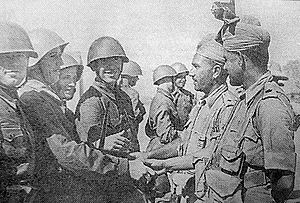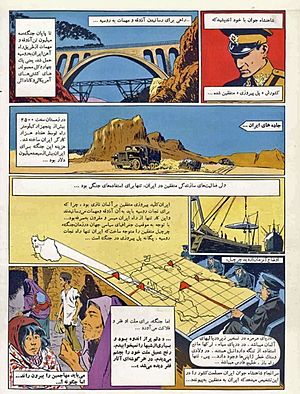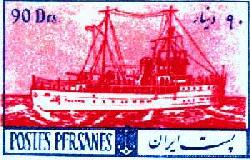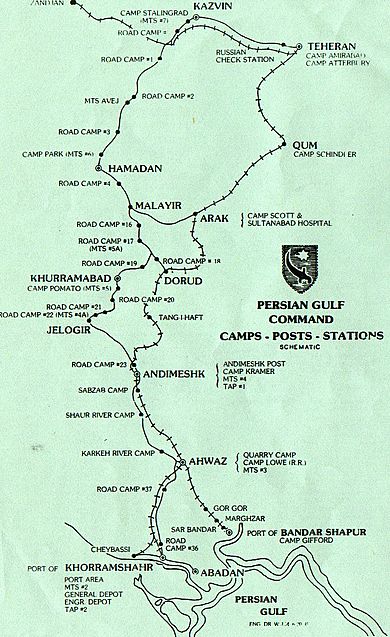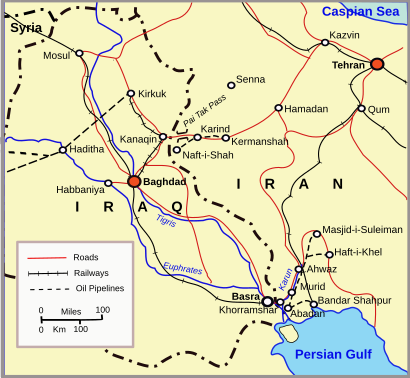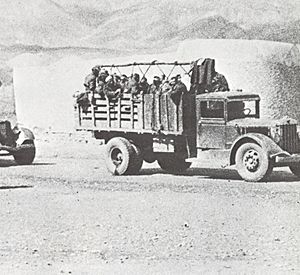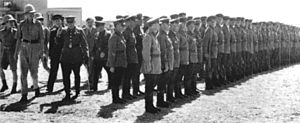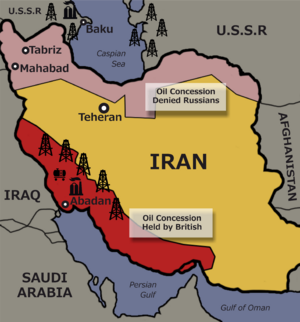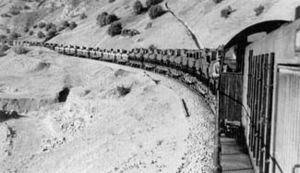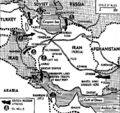Anglo-Soviet invasion of Iran facts for kids
Quick facts for kids Anglo-Soviet invasion of Iran |
|||||||||
|---|---|---|---|---|---|---|---|---|---|
| Part of the Mediterranean and Middle East theatre of the Second World War | |||||||||
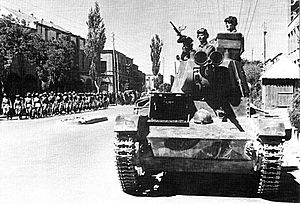 Soviet tankmen of the 6th Tank Division drive through the streets of Tabriz on their T-26 light tank. |
|||||||||
|
|||||||||
| Belligerents | |||||||||
• • |
|||||||||
| Commanders and leaders | |||||||||
| Strength | |||||||||
| Soviet: 3 armies British: 2 divisions and 3 brigades 4 sloops 1 gunboat 1 corvette 1 armed merchant cruiser 1 armed yacht Unknown number of auxiliary vessels |
9 divisions 60 aircraft 2 sloops 4 patrol boats |
||||||||
| Casualties and losses | |||||||||
| Soviet: 40 KIA 3 planes lost British: 22 KIA 50 WIA 1 tank destroyed |
~800 KIA 2 sloops sunk 2 patrol boats captured 6 planes lost |
||||||||
| Civilian casualties: ~200 Iranian civilians killed |
|||||||||
| Map of the invasion | |||||||||
The Anglo-Soviet invasion of Iran was a joint attack on the neutral country of Imperial State of Iran in August 1941. It was carried out by the United Kingdom and the Soviet Union. These two powerful nations said they would stay in Iran until six months after World War II ended. They finally left in May 1946.
This invasion was called Operation Countenance. The Iranian forces were not as strong or as well-equipped. So, they could not stop the invasion. The fighting started on August 25 and ended on August 31, 1941. Iran's government agreed to surrender after a ceasefire on August 30.
The invasion happened two months after Germany attacked the Soviet Union. This attack, called Operation Barbarossa, made the Soviet Union allies with the United Kingdom. Before this, the Allies had already won battles against pro-German forces in nearby Kingdom of Iraq and Syria and Lebanon.
The main reasons for the invasion were to:
- Protect the Allied supply routes to the Soviet Union. This route was known as the Persian Corridor.
- Keep control of Iran's important oil fields.
- Reduce Germany's influence in Iran. Iran's leader, Reza Shah, had been working with Germany to balance British and Soviet power.
- Stop a possible German advance through Turkey and Iran towards the Baku oil fields or British India.
After the invasion, on September 16, 1941, Reza Shah was forced to give up his throne. He was sent away by the British. His young son, Mohammad Reza Pahlavi, became the new Shah.
Contents
Why Did the Invasion Happen?
In 1925, Persia became a united country under Reza Khan. He became Reza Shah. In 1935, he asked other countries to use "Iran," which was the country's historical name. Reza Shah started big plans to modernize Iran's economy, culture, and military.
Iran had been divided and isolated. Reza Shah's government built schools, roads, and modern cities. He tried to keep Iran neutral in world affairs. But he needed money from Western countries for his projects.
Growing Concerns About German Influence
In early 1940, Britain was fighting Germany in North Africa. Britain worried about Germany getting access to the Persian Gulf. This was especially true because Germany and the Soviet Union had a non-aggression pact. Britain started saying that Iran supported Germany.
Even though Reza Shah said Iran was neutral in World War II, Iran became very important to Britain. Britain feared that the Abadan Refinery might fall into German hands. This refinery was owned by the British Anglo-Iranian Oil Company. It produced a lot of oil, which was vital for the Allied war effort.
Relations between Britain and Iran were already tense. In 1931, the Shah had changed an old oil agreement. This agreement had given Britain's oil company exclusive rights to Iran's oil. The Shah felt Iran was not getting a fair share of the profits. He renegotiated a better deal, but it made Britain think he was against their oil interests.
The Soviet Union Joins the Allies
In June 1941, Germany invaded the Soviet Union. This made Britain and the Soviet Union allies. This new alliance made the invasion of Iran even more urgent for them. The Trans-Iranian Railway was a key route. It could be used to send supplies from the United States to the Soviet Union. This was part of the Lend-Lease program.
British and Soviet leaders knew how important this railway was. They wanted to control it. Shipping supplies through the Arctic was dangerous due to German U-boat attacks and winter ice. So, the railway through Iran became a very attractive option.
Britain and the Soviet Union put pressure on Iran and the Shah. This caused tension and anti-British protests in Tehran. Iran's location was also a threat to Soviet oil fields in the Caucasus region. Any German advance south-east would threaten British connections between India and the Mediterranean Sea.
In July and August, the Shah refused demands to expel German citizens from Iran. Most Germans were workers and diplomats. A British report from 1940 said there were about 1,000 Germans in Iran. Another source said there were 690 Germans out of 4,630 foreigners. Some believed Germans had too much influence in important industries and transport.
However, Iran did start to reduce its trade with Germany. Reza Shah wanted to stay neutral. But this became harder with the demands from Britain and the Soviet Union. British forces were already in Iraq after a conflict there in May 1941.
The Invasion Begins
The Allied forces described the invasion as fast and easy. Before the attack, Britain sent two diplomatic messages to Iran. They demanded that German citizens leave Iran. The second message was seen as an ultimatum by Iran's prime minister, Ali Mansur.
After the invasion began, the British and Soviet ambassadors were called to meet the Shah. He asked why they were invading and why they had not declared war. They both said it was because of "German residents" in Iran. When the Shah asked if they would stop if he expelled the Germans, they did not answer. The Shah sent a telegram to US President Franklin D. Roosevelt. He asked Roosevelt to stop the invasion. The US was neutral, so Roosevelt could not help. But he said he believed Iran's "territorial integrity" should be respected.
Allied Forces Attack Iran
The British Royal Navy and Royal Australian Navy attacked from the Persian Gulf. Other British forces came by land and air from Iraq. The Soviet Union invaded from the north. They used their 44th, 47th, and 53rd armies. Air force and naval units also took part. The Soviets used about 1,000 T-26 tanks.
Six days after the invasion, British divisions in Iraq were renamed "Persia and Iraq Force" (Paiforce). This force included Indian infantry divisions and armoured brigades.
Iran's army had nine infantry divisions, some with vehicles. They had between 126,000 and 200,000 soldiers. Iran had tried to build a modern army. But they lacked enough training, tanks, and air power to fight a multi-front war. Reza Shah's modernizations were not finished. The army had been more focused on controlling its own people than fighting invaders.
The Iranian army used vz. 24 rifles and other Czech small arms. They had bought 100 FT-6 and Panzer 38(t) light tanks. They also had some AH-IV tankettes and armoured cars. But these were not enough to stop two major powers. Many of their tanks were outdated by 1941. The Iranian Air Force had older planes like biplanes.
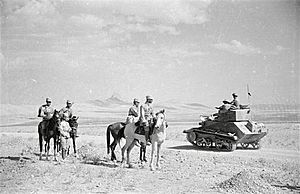
The Iranians had little time to prepare a defense. The Allies achieved a surprise attack. The war began early on August 25. British planes bombed targets in Tehran and Qazvin. They dropped leaflets telling Iranians to surrender. Soviet planes bombed cities like Tabriz and Ardabil. Civilian areas were hit, and hundreds were killed or wounded. Reza Shah refused to destroy roads and transport networks. He did not want to damage the infrastructure he had built. This helped the Allies win quickly.
Iranian resistance was quickly overcome by Soviet and British tanks and soldiers. The British and Soviet forces met at Sanandaj and Qazvin on August 30 and 31. Facing huge defeats, the Shah ordered his military to stop fighting on August 29, four days into the invasion.
British Attacks in the South
Capturing Oil Ports
The British navy attacked Bandar Shahpur, Abadan, and Khorramshahr. This attack began at dawn on August 25, 1941.
At Abadan, the British ship HMS Shoreham sank the Iranian ship Palang with one shot. The Abadan Refinery was very important to the British. They also wanted to keep their oil company employees safe. Iranian forces in the area had 27,000 troops and all their tanks. The British captured the refinery and city after intense fighting.
The Australian ship HMAS Kanimbla landed troops at Bandar Shapur. They faced no resistance from Iranian patrol boats. Seven German merchant ships were captured. The naval base was secured that evening. At Khorramshahr, HMAS Yarra sank the Iranian ship Babr. The head of the Iranian navy, Gholamali Bayandor, was killed.
The surprise attack meant there was almost no resistance in other parts of Khuzestan. The British Air Force attacked airbases and quickly gained control of the sky.
The 8th Indian Division advanced from Basra and captured Khorramshahr. The Karun River was not fully secured right away due to Iranian snipers. Britain also landed troops at Bandar Abbas.
The British planned to capture Ahvaz and then move north into the Zagros Mountains. They wanted to reach Qazvin to meet Soviet troops. By August 27, British forces reached Ahvaz. Iranian forces, led by General Mohammad Shahbakhti, had prepared a strong defense. They had dug in with artillery and tanks. An attack by the Indian Army was stopped by Iranian tanks and soldiers.
On August 29, Iranian commanders at Ahvaz learned that their government had agreed to a ceasefire. They stopped fighting. The British and Iranians agreed that Iranian soldiers would stay at their posts. British troops would join them for a parade in the city. Iranians would also safely evacuate British residents.
British Advance into Central Iran
Further north, the 10th Indian Infantry Division attacked central Iran. This force gathered at the Iraqi border town of Khanaqin.
The British force crossed the border at Qasr-e Shirin. They moved into the Naft-e Shah oilfield with little resistance. The British Air Force supported the ground troops. They shot down six Iranian fighters without any losses, ensuring air superiority. They also bombed towns and dropped leaflets asking for surrender.
The main Iranian forces in this area were 30,000 troops with artillery. They were light infantry. The British reached the edge of Shahabad on August 28. By August 29, the British reached Kerend-e Gharb. They were close to Kermanshah when the ceasefire order came. The defenders declared Kermanshah an open city. The British entered on September 1.
Soviet Attacks in the North
Invading Northwestern Iran
Soviet forces attacked on August 25. Iranian airbases were destroyed by air attacks. The Soviets used three armoured groups with over 1,000 tanks. The Iranians had no tanks in this area. The 47th Army crossed from Soviet Azerbaijan into Iranian Azerbaijan. They moved towards Tabriz and Lake Urmia. They captured the city of Jolfa. An Iranian plane saw Soviet forces moving towards Marand. The Iranian 3rd Division could have stopped them, but they were surprised and failed to counter-attack. They also failed to destroy bridges, allowing the Soviets to move quickly.
The 53rd Army crossed the border towards Ardabil. This city was defended by Iran's 15th Division. Two Iranian regiments moved to confront the invaders. However, their general, Qaderi, abandoned his troops. He even ordered supply trucks to unload weapons to carry his personal belongings. This left Iranian troops without support, leading to a quick defeat. On another front, the Soviet Army attacked Alikaran. Iranian border guards were surprised. Their officer, Khalil Alinejad, ordered his troops to warn the villagers while he and a few others provided cover. Officer Alinejad and his men were killed. Alikaran was quickly captured. Ardabil was bombed by the Soviet Air Force. Both the 15th Division in Ardabil and the 3rd Division in Tabriz began to fall apart. Despite this, regular troops tried to keep order. They marched towards the enemy without many commanders. But without food, supplies, and ammunition, they had to leave their heavy equipment. Some groups fought hard until the end but were defeated. By August 26, the Soviets occupied all of Iranian Azerbaijan, including Tabriz and Ardabil.
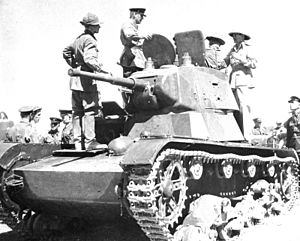
On August 25, the Soviet attack on Gilan Province began with their Caspian Sea Flotilla. This fleet had many patrol boats, destroyers, and landing craft. Facing them were three Iranian gunboats. Meanwhile, the 44th Army crossed the border into Gilan. They moved along the Astara highway and the main coastal highway. Strong Iranian forces in the area made the naval landing force secure cities. The fleet landed troops and quickly captured Astara.
Iranian forces sank barges at the entrance to Pahlavi harbour. They moved 75 mm guns to the area. The Iranians fought hard and prevented the Soviets from landing. They were careful not to fire their guns when Soviet planes were overhead. Soviet planes were kept away by Iranian anti-aircraft guns.
The next day, the Soviet Air Force used many heavy bombers. In groups of four, they attacked military and civilian targets throughout Gilan. At least 200 civilians were killed. The bombings destroyed many Iranian positions. Resistance was finally crushed by the 44th Army advancing from land. They captured both cities. Fighting was very intense, and the Soviets suffered their heaviest losses here. But without tanks and air power, the Iranians could not stop them. On August 28, they were forced to surrender. Some Iranian forces refused to give up and retreated to Ramsar to continue fighting. But their efforts ended when the Iranian government announced a ceasefire the next day.
Soviet Push Towards Iran's Center
Meanwhile, the Soviet invasion force in Iranian Azerbaijan moved south. The 47th Army was delayed near Jolfa. Three Iranian soldiers managed to block an important bridge until they ran out of ammunition. The Soviets did not use artillery to avoid damaging the bridge. The 47th Army moved south, capturing Dilman and then Urmia. They claimed this was to block "German agents." Urmia was defended by only a few snipers. The Soviets bombed targets in the city, killing over a dozen people. Much of the city's market was burned.
The 53rd Army moved south of Ardebil towards the Tehran-Karaj-Tabriz highway. They captured Mianeh, East Azerbaijan and moved southeast towards Qazvin and Tehran by August 27–28. Iran's 15th and 3rd divisions had already been defeated. There was only scattered resistance. The Soviet armoured forces drove down the highway. They were ready to take Qazvin on August 29. Then they planned to take Saveh and Qom, south of Tehran. This would cut the main Tehran-Saveh-Persian Gulf highway and divide Iran in two. But the Iranians accepted the ceasefire on August 29. The Soviets entered Qazvin on August 30. At the same time, parts of the 53rd Army captured Hamadan. One child was killed in a small bombing raid.
The End of the Invasion
By August 28–29, 1941, Iran's military was in complete disarray. The Allies controlled the skies. Large parts of the country were in their hands. Major Iranian cities like Tehran were bombed repeatedly. In Tehran, few people were killed, but the Soviet Air Force dropped leaflets. They warned of a massive bombing raid and urged surrender. Tehran faced water and food shortages. Soldiers fled, fearing capture by the Soviets. The royal family, except the Shah and Crown Prince, fled to Isfahan.
The collapse of the army that Reza Shah had built was humiliating. Many generals had acted poorly or secretly supported the British. They ended up weakening Iran's resistance. The army generals met secretly to discuss surrendering. When the Shah found out, he beat the head of the armed forces, General Ahmad Nakhjavan, with a cane. He stripped him of his rank. The Shah almost shot him but sent him to prison instead.
The Shah ordered the pro-British Prime Minister, Ali Mansur, to resign. He blamed Mansur for lowering military morale. Mohammad Ali Foroughi, a former prime minister, replaced him. The Shah ordered the Iranian military to stop fighting and agree to a ceasefire. He began talks with the British and Soviets.

Foroughi was not a friend of Reza Shah. He had been forced to retire earlier, and his son was executed. When he talked with the British, Foroughi suggested that he and the Iranian people wanted to be "liberated" from the Shah's rule. The British and Foroughi agreed on terms for the Allies to leave Iran. German officials and their staff had to leave Tehran. German, Italian, Hungarian, and Romanian offices had to close. All remaining German citizens, including families, had to be handed over to British and Soviet authorities. This last demand meant they would likely be imprisoned or possibly killed by the Soviets. Reza Shah delayed this. He planned to secretly evacuate all German citizens from Iran. By September 18, most Germans had escaped through Turkey.
Because the Shah resisted, the Soviet Army moved to occupy Tehran on September 16. Many wealthy people fled the city, fearing execution by the communists. Reza Shah announced he was giving up his throne. The Soviets entered the city on September 17. The British wanted to bring back the Qajar Dynasty, who had served British interests before Reza Shah. But the heir to that throne was a British citizen who did not speak Persian. So, Crown Prince Mohammad Reza Pahlavi became the new Shah of Iran. Reza Shah was arrested before he could leave Tehran. He was held by the British and sent to South Africa, where he died in 1944. The Allies left Tehran on October 17. Iran was divided between Britain and the Soviet Union for the rest of the war. The Soviets were in northern Iran, and the British were in the south.
What Happened During the Occupation?
The Persian Corridor became a vital route. Over 5 million tons of supplies were sent through Iran to the Soviet Union and British forces. In August 1942, German spies spread leaflets in Tabriz. An underground group called Melnune Iran was formed. This group caused anti-government protests. Some Iranian groups also resisted the new government.
The new Shah signed a treaty with Britain and the Soviet Union on January 29, 1942. This treaty said the Allies would leave Iran within six months after the war ended. In September 1943, Iran declared war on Germany. This allowed Iran to join the United Nations (UN). At the Tehran Conference in November 1943, leaders like Roosevelt, Winston Churchill, and Joseph Stalin promised to respect Iran's independence. They also offered economic help. The treaty stated that Iran was not "occupied" but was an Allied member.

The war greatly disrupted Iran. Government services were damaged. Food and other important items became scarce. The Soviets took most of the harvest in northern Iran. This led to food shortages for the public. The British and Soviet occupiers used grain as a bargaining tool. The food crisis worsened because foreign troops needed food and used the transport network. The British pressured the Shah to appoint Ahmad Qavam as prime minister. He managed the food supply and economy poorly. In 1942, there were bread riots in Tehran. martial law was declared, and some rioters were killed. Inflation increased by 450 percent, causing hardship for many. Some areas experienced famine. There was almost no armed resistance against the occupation.
In 1943, 30,000 Americans helped manage the Persian Corridor. About 26–34 percent of supplies sent to the Soviet Union through the Lend-Lease Act went through Iran. The Americans also assured Iranians that they would respect Iran's independence. The US also gave Lend-Lease aid to Iran and began training the Iranian army.
There were two German attempts to act against the Allies in Iran in 1943. Abwehr's Operation Francois tried to use a local group to sabotage Allied supplies. Also in 1943, Operation Long Jump was a failed German plot to kill Allied leaders (Stalin, Churchill, and Roosevelt) at the Tehran Conference.
When Did the Allies Leave?
On December 12, 1945, a Soviet-backed group created the People's Republic of Azerbaijan. Another group, the Kurdish People's Republic, was also set up in late 1945. Iranian government troops sent to regain control were blocked by Soviet army units.
The deadline for withdrawal was March 2, 1946. The British began to leave. But Moscow refused, saying there were "threats to Soviet security." Soviet troops did not leave Iran until May 1946. This happened after Iran officially complained to the new United Nations Security Council. This was the first complaint filed by a country in the UN's history. It was a test for the UN's ability to solve global issues after the war. However, the UN Security Council did not directly force the Soviets to leave.
See Also
- List of British military equipment of World War II
- List of Soviet Union military equipment of World War II
- Anglo-Iraqi War (1941)
- Anglo-Persian Oil Company
- Anglo-Persian War (1856–1857)
- Anglo-Russian Convention of 1907
- Anglo-Soviet Treaty of 1942
- Dunsterforce
- Foreign interventions by the Soviet Union
- History of Iran
- 1941 Iranian legislative election
- Iran-Britain relations
- Iran-Russia relations
- Iraqforce
- Persian Campaign in World War One
- Persian Corridor
- Russo-Persian Wars
- Trans-Iranian Railway
- 1953 Iranian coup d'état
Images for kids



